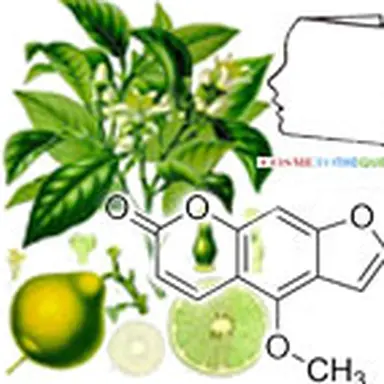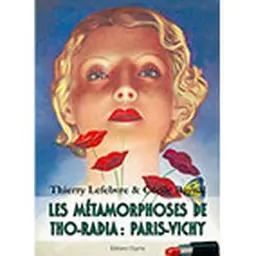
In the series"Forgotten Concepts", we address today the often discussed question of skin colour in relation to tanning. This question is important and has always been a central concern in the beauty process and, by extension, in the cosmetics industry. Many approaches have been considered, ranging from very light skin to tanned skin, with the notion of colour taking precedence, and the notion of safety only intervening later.
In this spirit, the idea that having melanin manufactured by the skin more quickly could constitute a satisfactory approach, and an effective countermeasure against the harmful effects of the sun, was born. Many projects have existed in this sense, organised around the theme of"premelanin" or"promelanin". The first products appeared in the 70s using among others tyrosine (Golden Range Beauty™ Helena Rubinstein). Today we relate an episode related to a specific brand, Bergasol, which marked its time with a particular approach. The basic idea was to use the sensitizing properties of bergamot oils to promote the appearance of tanning. Certain components of these oils are also used in skin pathology applications, PUVA therapy among others . This episode must be seen in the context of the era when safety and efficiency were often sources of delicate compromises. Thanks to Céline Couteau and Laurence Coiffard for their contribution on this theme.
Jean Claude Le Joliff
Bergaptène and Bergasol, an epic of more than 20 years…Or how to tan at any price
In the 1970s, the field of topical photoprotection was still in its infancy. We do not place ourselves at all on a public health plan, even if the notion of"security" is very timidly emerging. PHAS products then have the slogan:"and your skin bronze, bronze safely". A young woman with a tanned complexion and wide protective glasses poses on the advertising inserts, showing that sunscreen and glasses go hand in hand for complete protection. But does this security only appear in the slogan? This is what one might think in view of the case that will soon shake public opinion and the cosmetics industry. Companies are on the same level in the aesthetic field: it is necessary to tan effectively and with the least possible inconvenience. Sunburn should be avoided because it is painful and unsightly, period! He's not considered dangerous. A little help can even be given to"skins that do not brown easily". The use of ingredients such as bergamot, orange or lemon, which"optimize" the action of UV rays, is recommended. Examples are Bergasol and Bergaplage. The bergapten contained in these products has caused much ink to flow and is at the origin of a soap opera that will last more than 20 years. This molecule is well known in the medical field since it has been used in the therapeutic field for four millennia.
| Periods | Characteristics |
| 2000 B.C. - 1930 | Description of the cutaneous effects related to the association sun and photosensitizing plants. The psoralenes involved are contained in Apiaceae ( Ammi majus ) and Legumes ( Psoralea corylifolia ). Egyptians and Indians use it to treat diseases such as vitiligo. Topical and oral pathways are used. Note that vitiligo is called white leprosy in India. |
| 1930 - 1960 | Extraction, identification of chemical structures - synthesis of psoralens. The structure/activity relationship is elucidated. Vitiligo is treated orally and topically with 8-MOP (8 methoxypsoralen). |
| 1960 - 1988 | Increasing the number of toxicological studies both in vivo than in vitro . Determination of effects on long-term treated patients. This is the golden age of puvatherapy, a combination of psoralen treatment and irradiation in the UVA domain. |
|
1989
|
Framed phototherapy - orientation towards narrow spectrum UVB phototherapy. |
| 2004 | A study in Grenoble reviews 26 years of high-dose phototherapy. The risk of skin cancer is not excluded. Dermatological follow-up must therefore be carried out for each patient treated. |
Psoralenes: molecules for the treatment of certain skin conditions - four millennia of use
Forgetting the phototoxic properties of psoralens, journalists in some women's magazines in the 1970s sang the praises of this category of molecules presented as revolutionary. They would accelerate tanning and would therefore be beneficial. One journalist states peremptorily (in speaking of psoralens) that these products, long considered harmful, even dangerous, seem to be (after long research) perfectly developed today "even if they" remain however contraindicated to congestive temperaments ". (L'Officiel de la mode - n°600 - 1973). You don't see what the congestive aspect of the skin has to do with it. Nevertheless, the opinion remains unequivocal for the consumer who flips through the magazine in question.
The case is really not simple. To fully understand it, we must go back to its origin. In 1969, pharmacist Jean-Jacques Goupil launched Bergasol products, based on the concept"Bronzer quickly and safely". The evocative names of the product'Bergasol' and the pharmaceutical laboratory producing it,'Bergaderm', have been chosen in relation to the key ingredient, the famous bergapten, a furocoumarin known as 5-MOP (or 4-Methoxy-7 H -furo[3,2- g . benzopyran-7-or 5-Methoxypsoralen), and present in a number of essential oils such as bergamot.
This bergapten is not unanimously accepted in the scientific community and many critics are already raising their voices. The rumour swelled and reached the European Commission, which finally decided to ban the sale of Bergasol products in 1995. The case does not stop there, because this prohibition will be fatal to the company which is put into judicial liquidation on October 10, 1995. What is astonishing is the determination of the management of this laboratory to stick to its positions, in defiance of its own interests. Many competitors, who had surfed the Bergapten wave, had indeed abandoned essential oils and did not show such determination. Jean-Jacques Goupil has decided that if there is only one left, he will be that one! From a regulatory point of view, 5-MOP, used in the treatment of psoriasis in combination with UV radiation, has long been prohibited in sun and tanning products. But, what about the psoralenes naturally present in essential oils? This is the crux of the problem, all the more so as studies follow one another and contradict each other. Jean-Jacques Goupil finds a powerful ally in Thomas Fitzpatrick, an American dermatologist who is an authority in the field.
|
Among these studies, the most favourable for Bergasol are those conducted by Dr. Fitzpatrick, Professor of Dermatology at Harvard Medical School (United States of America). This scientist states that Bergasol is the most effective and safest sun oil ever developed, since it strongly multiplies the body's protective reactions against ultraviolet rays, and that the risk of carcinogenic effect of 5-MOP is negligible. According to him, the appearance of melanomas is more unlikely if Bergasol is applied than if solar oils without bergamot oil are applied. He also completes his thought: "…I would say…that this is a safe and, I believe, effective way to make people with type I or type II skin at high risk of skin cancer more resistant to the development of sun-induced skin cancers, on a par with those with phototype III and IV skin, and that it therefore gives them the same opportunity to develop new defences…". |
Arguments in favour of the Bergasol product put forward during the call made by the company
This information is relayed by the press, which sings an ode to the products containing bergapten, which,"is the only one that can be heard. according to leading dermatologists who have tested these products have concluded that, indeed, psoralen-based tanning agents help to brown faster. Moreover, they allow less exposure, which is a very positive point in the fight against skin withering: they also have the ability to activate protective elements enclosed under the epidermis: they therefore protect effectively ". (Fashion official n°633 - 1977).
Yet debates about 5-MOP date back to the mid-1980s, and some clearly denounce"the fact that 5-MOP is a the potential carcinogenic effects of bergamot oil as a component of suntan oil ". So, will limit or will not limit the dose of 5-MOP in sun products? 1987, 1990, 1991, 1992 and 1993 see successive commissions and experts clash. The adventure ended on 10 July 1995: the Commission adopted the 18th Directive (95/34/EC) which limits the presence of psoralens (i.e. 5-MOP) to 1 mg/kg in sun and tanning products. Ite missa est. Let us recall the important role played by Jean-Pierre Césarini in this war which for a long time opposed scientific reality and financial interests. This photobiologist dermatologist, concerned above all with human health, put himself at the service of this cause until reason triumphed.
Since then, the company Bergaderm has continued to live its life and was last bought by the pharmaceutical giant, Omega pharma. The"history" tab of the site always refers to the creator of the concept "Bronzer vite et bien en toute sécurité". The philosophy of Bergasol products is always the same: optimize tanning. However, the activator used today is harmless, since it is tyrosine, a tanning activator that is not controversial from a toxicological point of view, but probably not very effective either.
The moral of the story is one sentence:"remember the mistakes of the past". The Cosmetotheque®, by saluting the beautiful innovations (and they are numerous!) and by recalling the sometimes darker pages of the history of cosmetics, fits perfectly into this logic.
Source
•
Beauté mon beau souci - A history of beauty and cosmetics
Edilivre, 285 p, 2015.
|
Contribution made by Céline Couteau and Laurence Coiffard They work at the LPiC or Industrial Pharmacy and Cosmetology Laboratory of the Faculty of Pharmacy of Nantes. Born in the 1970s from the split of the Galenic Pharmacy Laboratory from the Faculty of Pharmacy in Nantes, the LPiC has been part of a logic of development of topical forms intended for both pharmaceutical and cosmetic use since its creation. On the research side, different themes have been developed over time. The most important part of the investigations carried out in the 1980s and 1990s was the enhancement of marine ingredients through the characterisation of the composition of macro- and micro-algae (creation of a database called Biotekalg). Then, the study of the thermo- and photo-stability of various ingredients for cosmetic use preceded the current theme of the laboratory, namely the study in vitro the effectiveness of sunscreen products. This theme, introduced in the 2000s, is currently translated into some forty international-level publications. This laboratory is also involved in training since since the creation of the Master 2 diploma, having succeeded a DESS, hundreds of executives have been trained in Nantes. |










